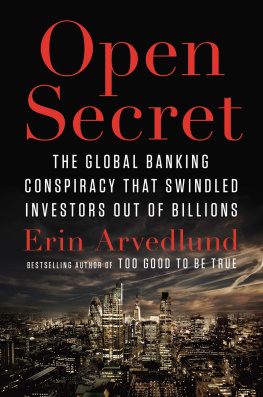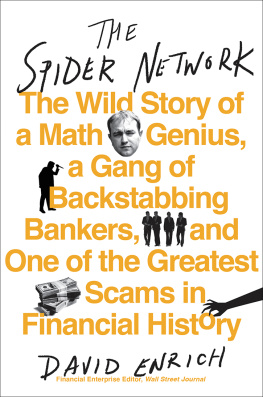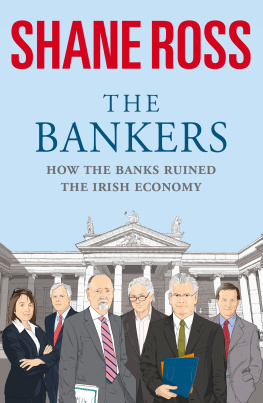USA | Canada | UK | Ireland | Australia | New Zealand | India | South Africa | China
First published by Portfolio / Penguin, a member of Penguin Group (USA) LLC, 2014
Penguin supports copyright. Copyright fuels creativity, encourages diverse voices, promotes free speech, and creates a vibrant culture. Thank you for buying an authorized edition of this book and for complying with copyright laws by not reproducing, scanning, or distributing any part of it in any form without permission. You are supporting writers and allowing Penguin to continue to publish books for every reader.
Arvedlund, Erin, author.
Open secret : the global banking conspiracy that swindled investors out of billions / Erin Arvedlund.
Includes bibliographical references and index.
1. Bank fraud. 2. Banking lawCriminal provisions. 3. Commercial crimes. 4. Global Financial Crisis, 2008-2009. 5. LIBOR market model. 6. Interest rate futures. I. Title.
While the author has made every effort to provide accurate telephone numbers and Internet addresses at the time of publication, neither the publisher nor the author assumes any responsibility for errors, or for changes that occur after publication. Further, the publisher does not have any control over and does not assume any responsibility for author or third-party Web sites or their content.
John A. Beattie Jr.
Cast of Characters
Wall Street Journal
Mark Whitehousejournalist
Carrick Mollenkampjournalist
Bankers Trust International
Evan G. Galbraithinventor of the floating-rate note
David Clarkbroker
U.S. Treasury
Timothy GeithnerTreasury secretary, 20092013
Henry PaulsonTreasury secretary, 20062009
Robert RubinTreasury secretary, 19951999
Jacob LewTreasury secretary, 2013present
Robert SteelTreasury undersecretary, 20062008
Manufacturers Hanover Limited
Minos Zombanakisinventor of the formula for LIBOR
Citigroup
Scott PengInterest rate strategist
UBS
Marcel Ospelgroup chair
Marcel RohnerCEO
Tom Alexander William Hayestrader
ICAP
Darrell Readbroker
Daniel Wilkinsonbroker
Colin Goodman (aka Lord LIBOR)broker
Michael Spencerfounder and chief executive
Federal Reserve Bank of New York
William Dudleypresident, 2009present
Timothy Geithnerpresident, 20032009
Federal Deposit Insurance Corporation (FDIC)
Sheila Bairchair, 20062011
British Bankers Association (BBA)
John Ewanmanaging director
Angela Knightchief executive, 20072012
Marcus Agiuschair, 20102012
Bank of England
Mervyn Kinggovernor, 20032013
Paul Tuckerdeputy governor, 20092013
U.S. Federal Reserve
Benjamin Bernankechair, 20062014
UK Parliament
John MannLabour minister
Barclays Capital
Robert E. Diamondchief executive, 19962012
Rich Riccicochief executive officer, 20002013
Jerry del Missierchief operating officer, 20002012
John Varleygroup chief executive, 20042011
U.S. Securities and Exchange Commission (SEC)
Mary Jo Whitechair, 2013present
Brevan Howard
Alan Howardco-founder
Royal Bank of Scotland (RBS)
Tan Chi Mintrader
Scott Nygaardhead of short-term markets for Asia and Edinburgh-based RBS
Paul Walkerhead of money market trading
Sim Suh-Tingexecutive director and head of regulatory risk and compliance (SE Asia)
Deutsche Bank
Anshu Jaincochief executive
U.S. Commodity Futures Trading Commission (CFTC)
Gary Genslerchair, 20092014
Vincent A. McGonagledirector of the Division of Market Oversight
Stephen J. Obieacting director of the Division of Enforcement
David Meisterhead of enforcement
Bart Chiltoncommissioner, 2007present
Jill Sommerscommissioner, 20072009
Mark Wetjenacting chairman, 20132014
Timothy Massadchairman, 2014present
Long-Term Capital Management (LTCM)
James G. RickardsWall Street lawyer and hedge fund investor
J.P. Morgan Chase
Paul Glandstrader
Rabobank
Piet Moerlandchairman, 20092013
New York University
Rosa Abrantes-Metzprofessor and director in antitrust, securities, and financial regulation practices of Global Economics Group
U.S. Department of Justice
Lanny Breuerhead, Criminal Division, 20092013
MF Global
Jon CorzineCEO and chairman, 20102011
James Koutoulashedge fund manager and MF Global customer
Prologue
T om Alexander William Hayes looked the part of the unremarkable British man. He sported short, dark blond hair, slightly wide-set eyes ringed with brown circles, a white button-down dress shirt, grayish blue V-neck sweater pilling on the back, and black trousers over black leather slip-on shoes. Like most Londoners commuting around town, he carried an umbrella, as that autumn day it was drizzling.
A private man by nature, Hayes remained largely in seclusion at his home in Surrey, with his wife and one-year-old son. He had stayed behind closed doors for good reason: On the days he did go out into the world, television cameras and paparazzi followed him like buzzards.
This particular day, October 21, 2013, was no exception. Outside the gray, modern-style courthouse, photographers waited to snap photos of him entering and leaving the building. Hayes offered no answers to their questions, yet one word seemed to hang over the proceedings as if written in Londons cloudy sky.
It was an acronym, one that consisted of five letters: L-I-B-O-R. Shorthand for London Interbank Offered Rate.
That little wordand its complex financial ramificationsrepresented countless billions of dollars in allegedly illegal gains and the means by which Hayes might lose his freedom.
Hayes had grown up in London, a middle-class lad with a gift for math and computers (a classmate called him an incredibly smart geek). His college record was such that employers flew him first-class to their offices for interviews, and, long before he became the poster boy for the largest financial scandal in London in anyones memory, he accepted, in 2001, a position as a junior trainee at the Royal Bank of Scotland.
At RBS, his specialty was derivatives, the financial instruments that, with the advent of electronic trading in the 1990s, represented finances new magic. Derivative agreements are contracts that specify an exchange of cash or other assets owned by one party for the second partys assets within some time frame. Hayess talents aligned nicely with Wall Streets growing appetite for derivatives. The market included options, swaps, and other transactions priced off of interest rates, commodities, and a variety of other underlying assets, and Hayes demonstrated a particular knack.











